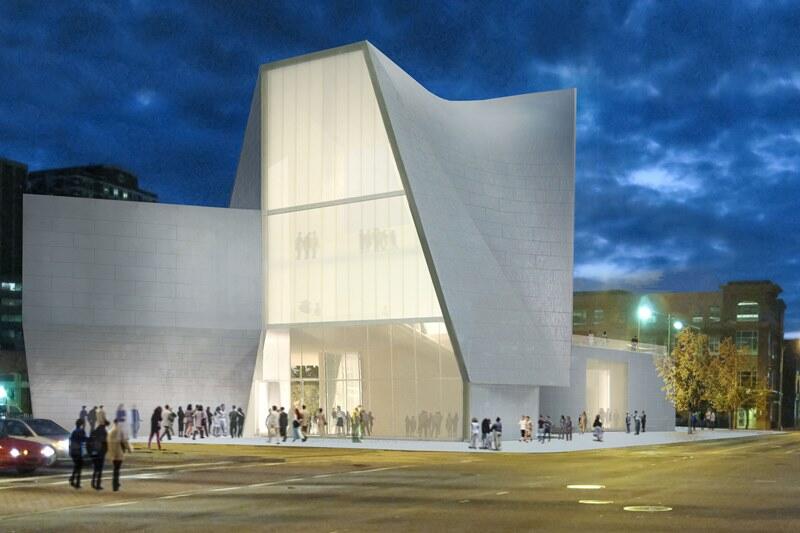
May 9, 2014
Virginia Commonwealth University will break ground on new Institute for Contemporary Art this summer
Share this story
Virginia Commonwealth University announced today that it will break ground in June on the Institute for Contemporary Art, a combination exhibition and performance space, laboratory and incubator for the presentation of visual art, theater, music, dance and film by nationally and internationally recognized artists.
The ICA, anticipated to open in 2016, is being built at the prominent corner of Broad and Belvidere streets within Richmond’s newly designated Downtown Arts District. Designed by Steven Holl Architects, the ICA will be a non-collecting institution that will present an array of different media and practices, mirroring the cross-disciplinary approach at the VCU School of the Arts.
“The ICA will be vital to the creative ecology of VCU and the community,” said VCU President Michael Rao, Ph.D. “Creative problem-solving skills are essential in our world today and this institution will bring new resources to our students and faculty working across the university, the nation and the globe.
“This institute will also be a significant beacon in Richmond in terms of economic and cultural development and bringing the arts community from around the world to our great city,” Rao said. “The ICA will help put Richmond on the global map as an arts destination.”
The ICA has raised nearly $31 million to date toward its $35 million goal for construction. A $20 million endowment campaign is also ongoing. In recognition of an important gift from Markel Corporation, the VCU Board of Visitors approved naming the new building the Markel Center. Additionally, leadership gifts to the ICA have been received from ICA Campaign co-chairs Steve and Kathie Markel and Pam and Bill Royall and donors True and Charlie Luck, Meg and John Gottwald, Abby W. Moore, the NewMarket Corporation, the Mary Morton Parsons Foundation, the VCU Real Estate Foundation and Carolyn K. and John W. Snow.
“This great university – and its considerable art resources – are essential to the vitality of our city,” said Steve Markel, vice chairman at Markel Corporation. “We are proud to have Markel Corporation associated with such an important institution and work of architecture, intended to welcome diverse communities and serve as a hub of creativity for our city.”
ICA Director Lisa Freiman said, “We are humbled and inspired by the generosity of our founding supporters. The ICA is an extraordinary gift to this and future generations, and we look forward to bringing this institution to life with the continued support of our community.”
The VCU School of the Arts is one of the nation’s leading arts schools, with distinguished alumni and noted artists at campuses in Richmond and Qatar, and has long been the top public university graduate arts and design program in the country according to U.S. News & World Report.
The ICA will complement and enhance the offerings of VCU while also serving as a new destination for contemporary arts and culture in the region and a cornerstone of Richmond’s already vibrant arts community — joining the Virginia Museum of Fine Arts, the Science Museum of Virginia, the Virginia Opera, Virginia Repertory Theatre, Richmond Ballet and the Richmond Symphony.
Located directly off Interstate 95 and at one of Richmond’s busiest intersections, the ICA will form a gateway to the university and the city. The ICA will feature dual entrances — one facing Richmond and the other fronting VCU’s campus. At the heart of the building will be an inviting, double-height “forum,” a flexible space for both spontaneous encounters and planned events that connects to the ground-floor performance space and opens to the garden and cafe.
The galleries radiate out from the forum in forked arms, shaping the space of the garden. The open circulation serves to remove the formal protocols associated with entering traditional arts facilities. The three levels of galleries are linked through the open forum, allowing artists to create works that extend across, and visitors to circulate through, the spaces via a variety of paths. The ICA's exterior walls of pre-weathered, satin-finish zinc will complement its urban setting. Additional clear and translucent glass walls will create transparency, bringing natural light into the building during the day and radiating light at night, signaling the activities taking place within.
For more information on the ICA, please visit: ica.vcu.edu.
Subscribe to VCU News
Subscribe to VCU News at newsletter.vcu.edu and receive a selection of stories, videos, photos, news clips and event listings in your inbox.







